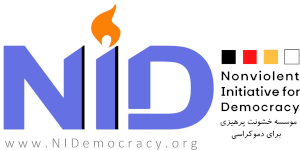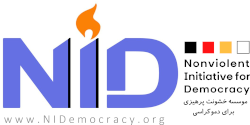George Lakey, a writer and activist in the field of nonviolent movements, argues that what causes a movement to disintegrate is not just repression but repression combined with the movement’s lack of preparedness.
The common assumption is that repression stops a movement, but historical evidence from over 1,200 cases of civil resistance in the Global Nonviolent Action Database suggests otherwise. There may also be individuals who view the dialectic between repression and the movement as more complicated, and they say that severe repression leads to the destruction of a movement, while mild repression actually leads to its expansion. It must be noted that the history of people’s struggles is filled with examples that have expanded in the face of severe repression, and many others that have subsided with very little repression.
Repression is a manifestation of power that often involves crushing the powerless, or at least preventing their rebellion. More concretely, repression includes the efforts of those in power to eliminate opposition and social movements that resist against a regime, corporation, or other influential institutions. According to scholars like Lee Smithey and Lester Kurtz, who are researchers in the field of nonviolent struggles, repression is a very complex phenomenon and is never limited to overt acts of violence. Instead, it includes various actions across a broad spectrum, which can be divided into at least six categories: overt violence, less lethal methods, threats and intimidation, direction and manipulation, soft repression, and, ultimately, hegemony.
The history of nonviolent struggles from the beginning until now shows that no regime can be certain that suppressing civil resistance will not bring about results against itself. This is the same phenomenon that Smithey and Kurtz refer to as the Paradox of Repression, and many other political scientists, including Erica Chenoweth, describe it as Backfire.
In their research titled The Paradox of Repression and Nonviolent Movements, Kurtz and Smithey formulate the unforeseen consequences of repression, which are not desirable for those in power, under the concept of the repression paradox. The achievement of people’s nonviolent power has been one of the most important accomplishments of modernity. Many nonviolent movements in the twentieth century have used the repression paradox or the backfire effect to their advantage. It should not be denied that violent movements have also used the repression paradox, but their use of violence often leads to losing the support of neutral observers, as we will see later as one of the fundamental conditions for the long-term success of a movement.
According to many researchers in the field of civil resistance, the paradox of repression works better when fighters understand the relative nature of the struggle and different sources of power well, and seek to benefit from them. Based on this perspective, the struggle should not be understood solely in the form of direct confrontation, but instead should be seen in any form of interaction among forces. Struggle is a fundamental part of human nature that occurs daily, and with an understanding of different sources of power, it can be harnessed in the service of a movement. For example, obedience is one of the six sources of power, and disobedience, which often achieves results with the least cost for the actor, can strike hard blows to the power structure.
Raphael Samuel, a political scientist, argues that repression is likely to have a reverse result when the survival of a government heavily relies on the obedience of its citizens. This only doesn’t lead to a reverse result in cases where the disobedience of a particular minority does not significantly affect the legitimacy of a regime. For this specific case, in Iran before the Woman, Life, Freedom Movement, civil disobedience in Kurdistan, Balochistan, and the Baha’i community can be cited as examples. Since the repression of these groups did not arouse the sympathy of the people, the regime was able to continue its suppression. However, during the Woman, Life, Freedom Movement, and especially after the Bloody Friday of Zahedan incident, the situation completely changed, and the regime realized that further repression of these minorities would not be without a reverse result.
It should be noted that it is not only nonviolent activists who seek to harness the backfire effect to their advantage. Brian Martin argues that those in power also try to reduce the effects of backfire results of repression in five ways: 1. covering up their violent actions; 2. reinterpreting what happened through lying, creating scenarios, and censorship; 3. blaming others; 4. using official channels to give an appearance of justice; and 5. manipulating, intimidating or rewarding the affected people involved. He formulated these under the term Outrage Management Model as used by regimes.
Whether the repression suppresses the opponents or makes them intensify their organization depends on various factors other than repression itself. Some of these factors are in the hands of the fighters, such as how the struggle is organized, movement strategy, the range of methods, the combination of different tactics for the struggle, the movement’s goals, and the method of communicating with impartial observers, whose support in continuing the struggle is a key condition for the movement’s success.
n her book Civil Resistance: What Everyone Needs to Know, Erica Chenoweth uses the term repression to refer to the use of coercive forces by governments and their agents (military, internal security services, paramilitary forces, or police) to influence the behavior of citizens. These actions include detention, mistreatment, harassment, torture, mass killings and genocide, enforced disappearances, executions, long-term imprisonment, and other human rights violations.
The common belief is that repression is specific to non-democratic regimes, but Chenoweth provides statistics that almost completely refute this universal belief. According to these statistics, 88% of nonviolent revolutions from 1900 to 2019 have faced “massive and lethal repression” by various regimes, while this figure stands at 94% for violent revolutions.
Lethal government repression can have different effects on civil resistance movements and lead to different outcomes. Repression can backfire, and cause the movement to significantly expand. It can also temporarily or permanently stop or extinguish the movement. However, the exact outcome is neither certain nor predictable, and depends on the level of violence employed in the repression and the strength of the ongoing movement.
Erica Chenoweth formulates the reaction of various nonviolent movements against repression into four categories: 1. some movements react to it with a rapid change of tactics; 2. some temporarily retreat to regroup and plan their next actions; 3. some turn to violence; and 4. some disintegrate.
For example, the Sudanese people’s uprising in response to the 2018 bread price increase, which was met with deadly repression by the government of Omar al-Bashir, not only did not silence the movement but also led to the creation of widespread solidarity in society and the emergence of a popular movement with new tactics. Sit-ins, paralyzing general strikes, and the Man with the Bin movement were among these tactics. During these protests, a Sudanese youth ingeniously used a trash bin to shield himself from tear gas canisters, a simple tactic that significantly altered the dynamics of street protests. This tactic became known as the Man with the Bin.
Temporary retreats will be effective, especially for times when overt and public activities are too dangerous, exactly like what is seen in Iran today. In this way, a movement focusing on daily forms of civil resistance can both reduce the costs and provide an opportune time for its reorganization.
It’s worth taking another look at the statistics collected by Erica Chenoweth and her colleagues regarding cases where movements against repression either subside or turn violent. Among 46 instances of one-sided government violence against unarmed protests from 1989 to 2011, hardly any led to change unless a broader civil resistance campaign took shape. In these cases, government one-sided violence resulted in backfire in half of the instances.
Jonathan Sutton, Charles Butcher, and Isak Svensson, in a study that examined these same 46 cases, found that even in situations where a government kills over a hundred people during nonviolent protests, if the civil resistance movement is strong enough, it will still have the potential for long-term success.
Evan Perkoski and Erica Chenoweth found out during their research that between 1955 and 2013, approximately 23% of nonviolent revolutions aimed at toppling regimes faced mass killings at some point in time. Mass killings are defined as situations in which at least a thousand unarmed civilians are killed. It is important to note that about 70% of violent struggles involving mass killings were perpetrated by governments in power, and even those suspected of supporting armed groups have been slaughtered.
In general, nonviolent campaigns that aimed to dismantle power structures from 1946 to 2013 witnessed fewer casualties compared to their armed counterparts. According to Chenoweth’s findings, violent movements had an average of 2,800 deaths per year, while nonviolent movements experienced 105 deaths per year on average.
In the book Protest Dialectics: State Repression and South Korea’s Democracy Movement, 1970-1979, Paul Y. Chang examines the short-term and long-term effects of state repression on the democracy movement in South Korea. According to his findings, following the severe repression of student protest movements in the 1960s, although the popular movement temporarily subsided, significant changes occurred in the 1970s, each of which can be considered as a backfire of repression.
After the suppression of student protests and the temporary decline in demonstrations, Christian activists, lawyers, and journalists each joined the anti-authoritarian movement in South Korea in their own way. In fact, government repression led to a more diverse range of participants in the movement. Furthermore, it also resulted in protest tactics that had previously been mostly street demonstrations taking on different forms, such as issuing statements, holding prayer protest ceremonies, worker strikes, and various tactics of non-cooperation for which suppression was not as easy as it was for street demonstrations and presences. All of these factors, ultimately contributed to broader public solidarity against the authoritarian government, which are all outcomes of the repression backfiring.



